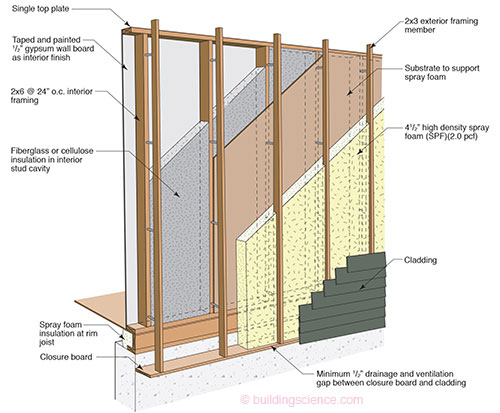This overview summarizes the offset frame wall construction including the advantages and disadvantages of this construction strategy. Complex two dimensional heat flow analysis and one dimensional hygrothermal modeling were used to determine moisture related durability risks for analysis.

- Cladding
- Minimum 1/2" drainage and ventilation
- 2x3 cantilevered wood frame wall at 24" o.c.
- 4 1/2" high density spray foam
- Substrate to support spray foam
- 2x6 interior wood frame wall at 24" o.c. with fiberglass or cellulose cavity insulation
- Interior gypsum wall board
Thermal Control
Installed insulation R-value: The amount of insulation installed in this wall system can be modified quite easily but in this case, 41/2” of high density spray foam (R-6/inch) is used on the exterior, and 51/2” of cellulose (R-3.7/inch) is installed in the stud space for a total installed insulation R-value of R-47. It is possible to install as much or as little spray foam insulation on the exterior as practical in specific cases.
Whole-wall R-value: Using two-dimensional heat flow analysis with thermal bridging effects and average framing factors, the thermal bridging in this wall system is significantly reduced by the uniform layer of spray foam over the exterior covering the rim joist and wall framing. The whole wall R-value for this assembly is approximately R-37.
Air Leakage Control: The exterior spray foam insulation is a perfect air barrier for this enclosure eliminating heat losses by air leakage through the wall. Air still could leak around penetrations such as windows, doors, and services if not detailed correctly.1
Typical Insulation Products: High density spray foam and fiberglass batt, blown cellulose, sprayed cellulose, or sprayed fiberglass.
Durability
Rain Control: For this wall system, the continuous water control layer will be the exterior surface of the high density foam. Rain screen cladding is installed directly on the exterior framing, and any moisture that passes through the cladding will drain against the high density spray foam. Intersections, windows, doors and other penetrations must be detailed to prevent the penetration of rainwater.2
Air Leakage Control: The continuous layer of high density spray foam prevents all air leakage through the enclosure system. Care should be taken to make sure that penetrations through the enclosure (windows, doors, services) are airtight. There should be no risk of air leakage condensation against the sheathing in most climates with 41/2” of exterior spray foam. In climate zone 8, more spray foam may be required, or the stud space insulation can be removed to ensure that there is no condensation.3
Vapor Control: TThe continuous layer of high density spray foam prevents vapor movement through the enclosure system. There should be no risk of vapor condensation against the sheathing in most climates with 41/2” of exterior spray foam. In climate zone 8, more spray foam may be required, or the stud space insulation can be removed to ensure that there is no condensation.4
Drying: This enclosure system will dry both to the interior, if the moisture is in the stud space, and to the exterior, if the moisture is in the cladding. Proper flashing of all penetrations should help minimize moisture in the enclosure. Ventilation behind vapor impermeable claddings and interior components (e.g. kitchen cabinets) can encourage drying.
Built-in Moisture: Care should always be taken to build with dry materials where possible, and allow drying of wet materials before closing in. Cellulose is often sprayed in wet, and manufacturer’s recommendation is to allow drying before closing in. Because no polyethylene vapor barrier is required, moisture in the stud space will be able to dry quite easily to the interior.
Durability Summary: Provided the minimum amount of spray foam insulation is exceeded for a given climate to keep the condensation plane above the dew point, there is virtually no risk to moisture condensation in the enclosure, and any small amounts of moisture in the enclosure will dry easily.
Cellulose insulation is typically treated with borates to protect itself and neighboring wood material from mold and decay. Cellulose insulation also has decreased flame-spread potential.
Buildability
This wall system does require some attention to detailing, and likely some initial training to install the exterior framing material, but the risks from poor construction are very minimal. Spray foam insulation is shipped as a liquid in two components and only mixed as it is installed, so shipping is much more efficient and reliable than board foam, which has been reported to arrive on the job site damaged, especially in remote areas. It is very quick and easy to dry in a structure with spray foam insulation to weatherproof it, which is critical in environments with short construction seasons. Interior finishing can be done even in inclement weather. This enclosure system has been used both in new construction and in retrofit situations in cold climates.
Cost
In most regions, high density spray foam is a relatively expensive method of insulating the enclosure, however the benefits of a complete air and vapor barrier, occupancy comfort, reduced energy consumption, and reduced risks to contractor errors may be worth the increased cost in some locations and situations.
Material Use
More framing materials are required for this enclosure assembly, as well as the higher embodied energy high density spray foam. Cellulose in the stud space has very low embodied energy.
Summary
This is highly insulated wall system that will work in extreme climates as part of a high-R enclosure.
References
- Straube, J. (2009, 04 22). BSD-014 Air Flow Control in Buildings.
- Lstiburek, J. W. (2006). Water Management Guide.
- Lstiburek, J. (2008, 08 20). BSD-104: Understanding Air Barriers.
- Lstiburek, J. (2008, 10 17). BSD-106 Understanding Vapor Barriers.
